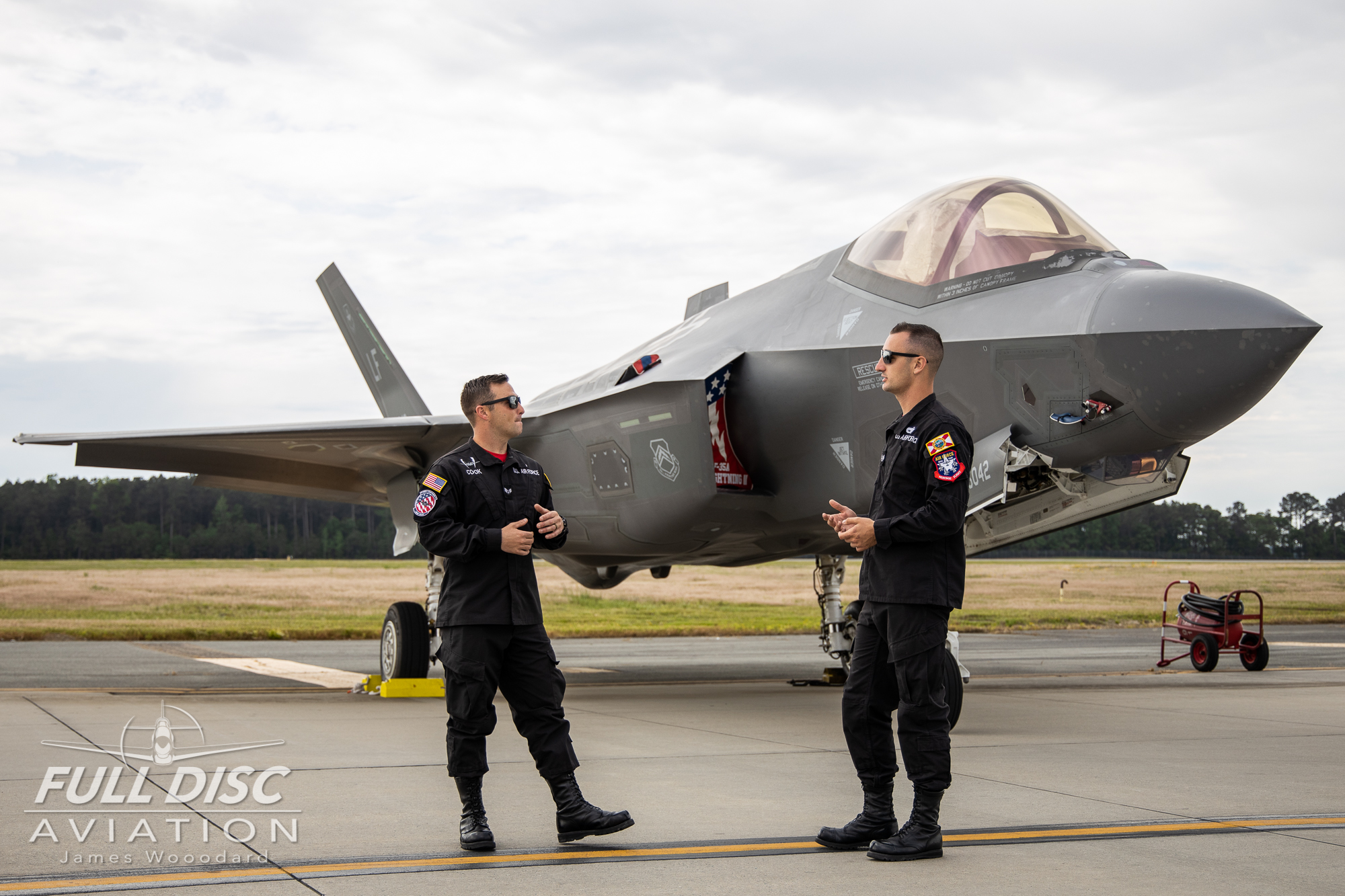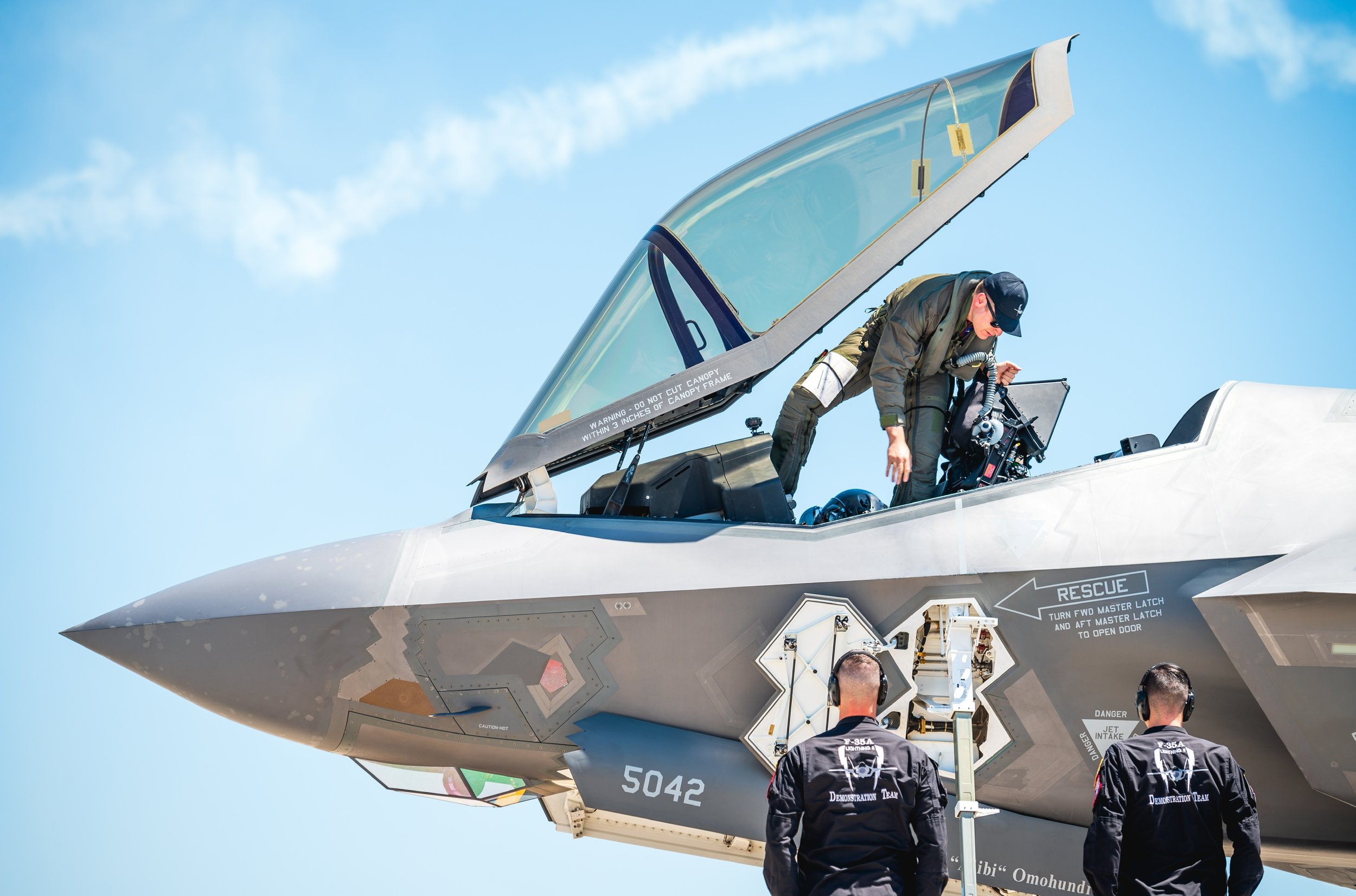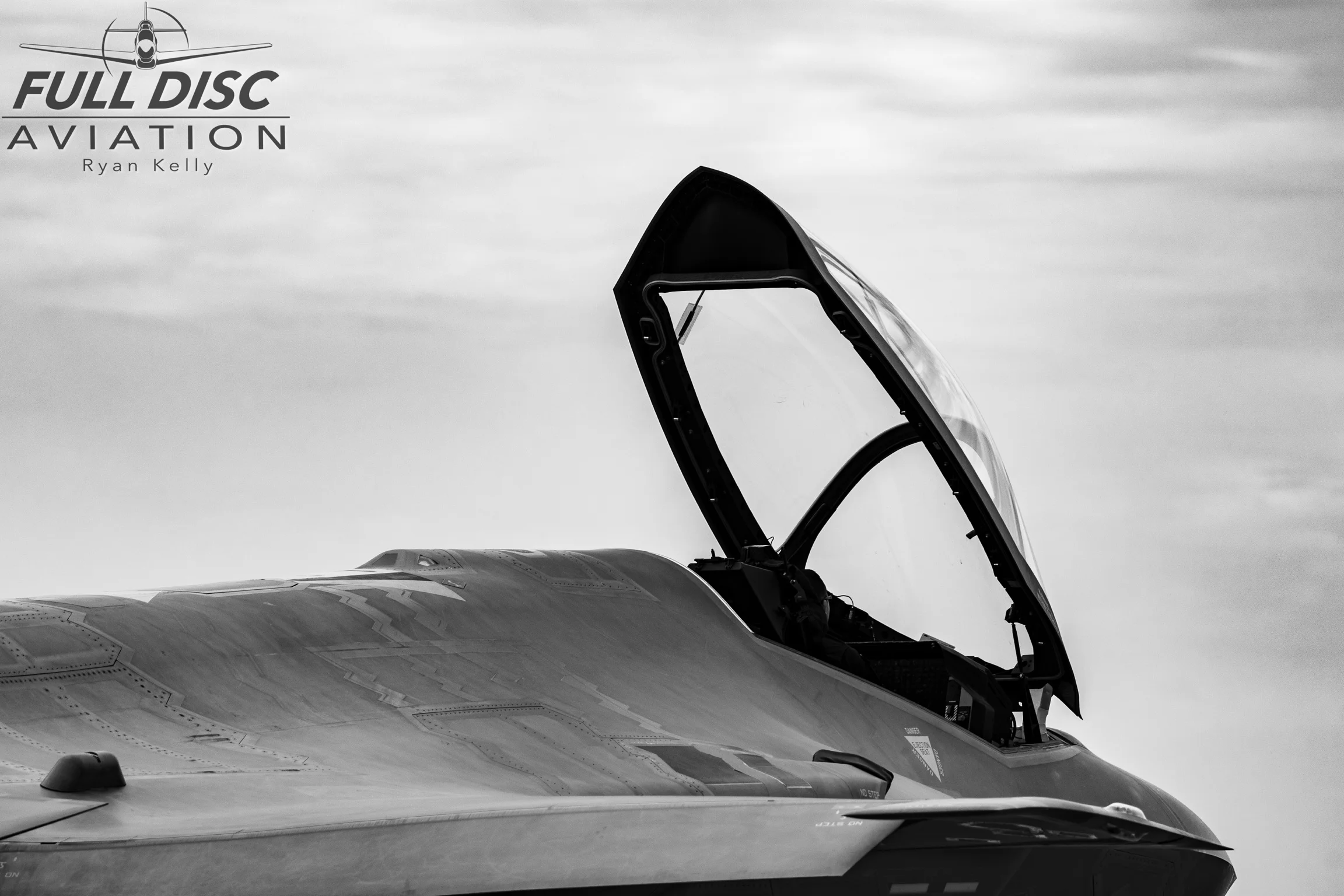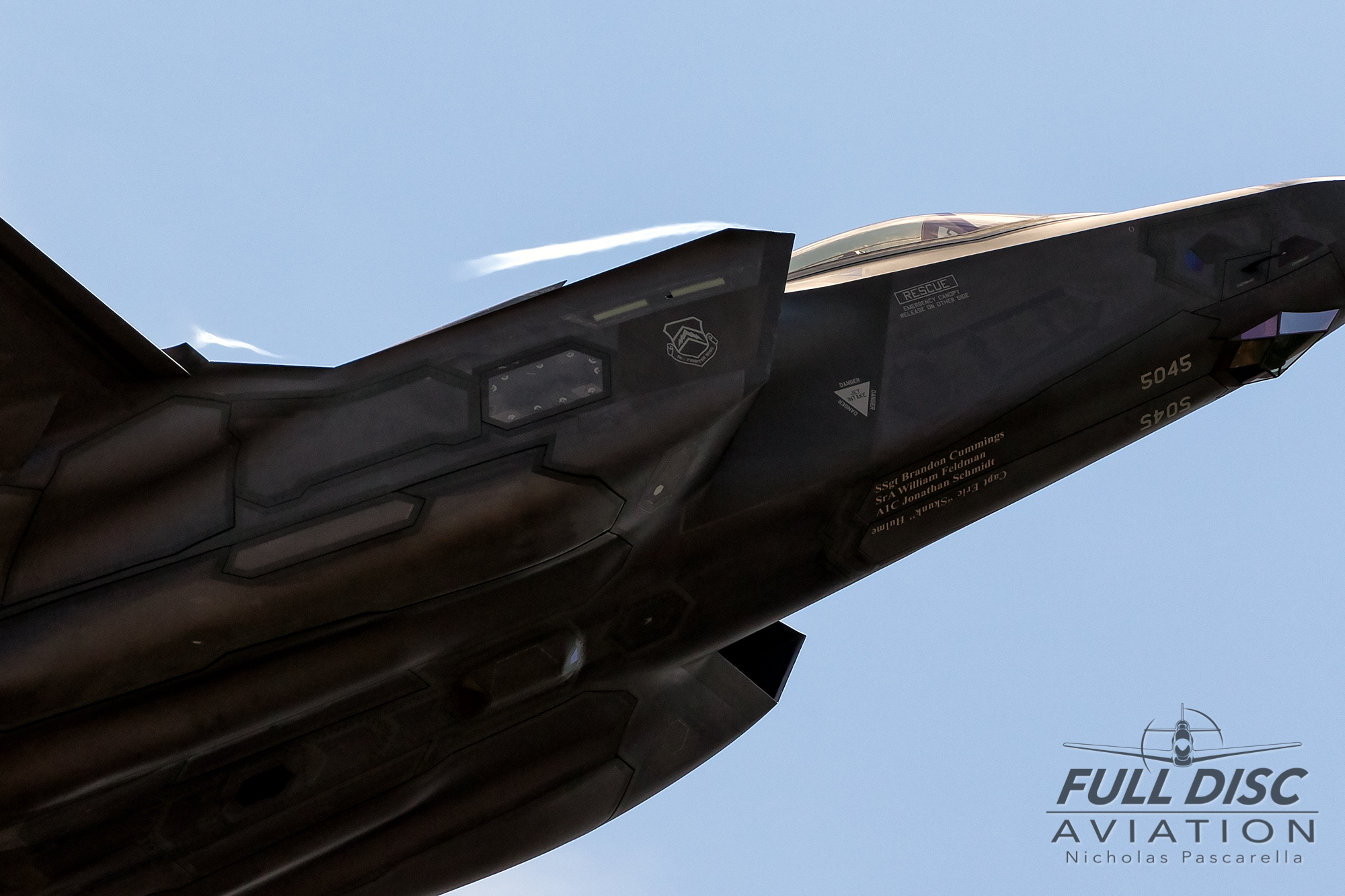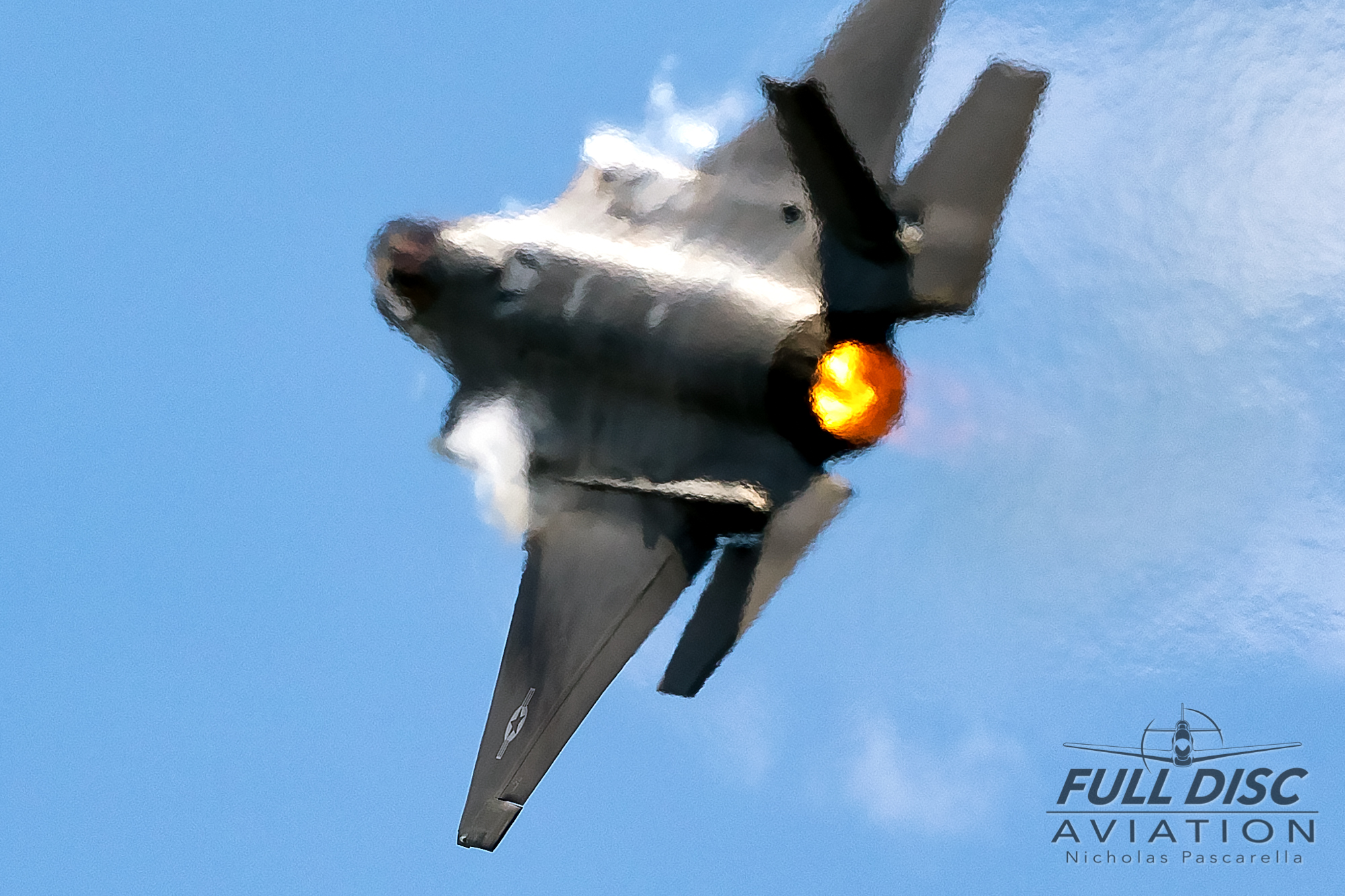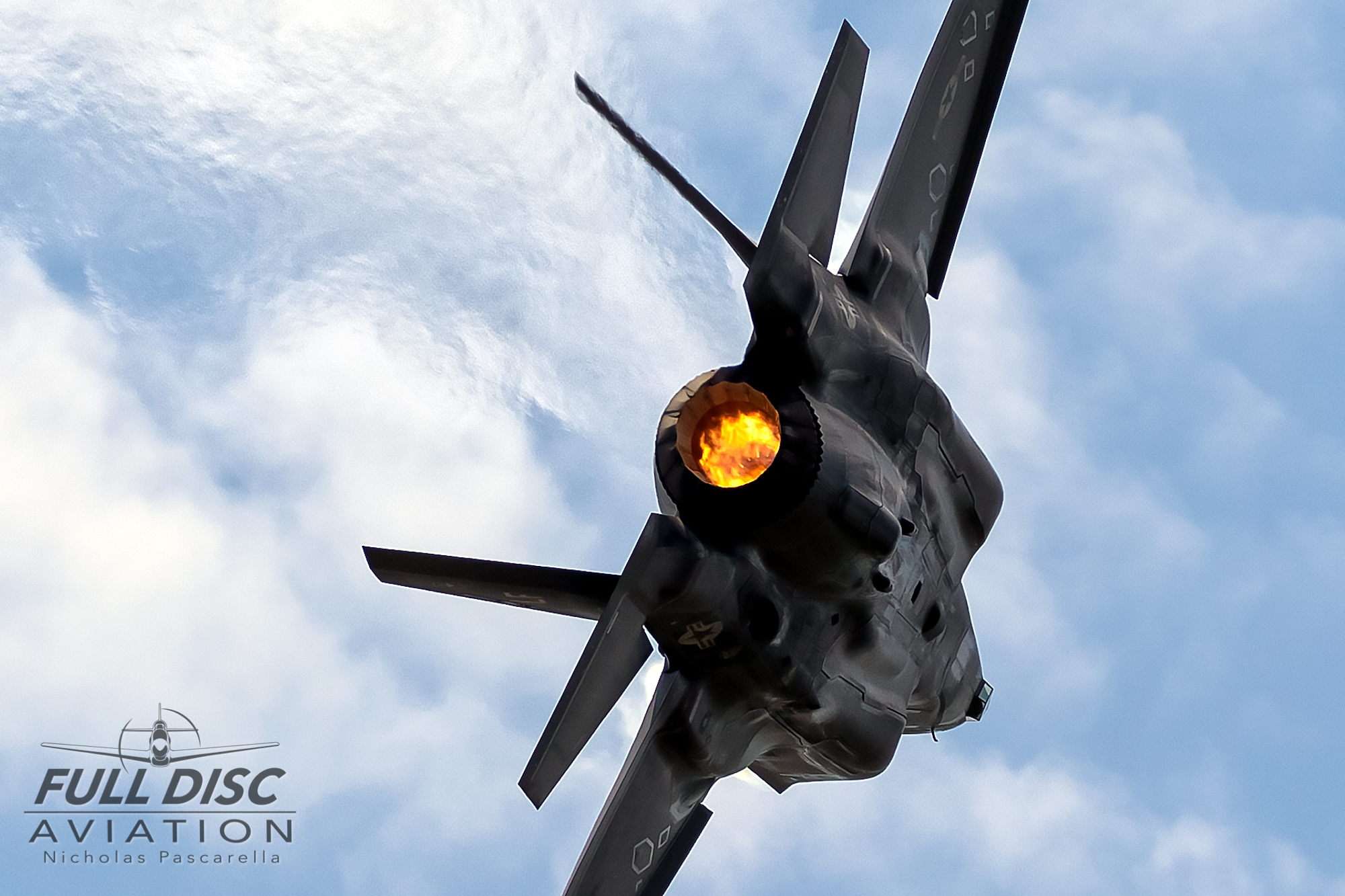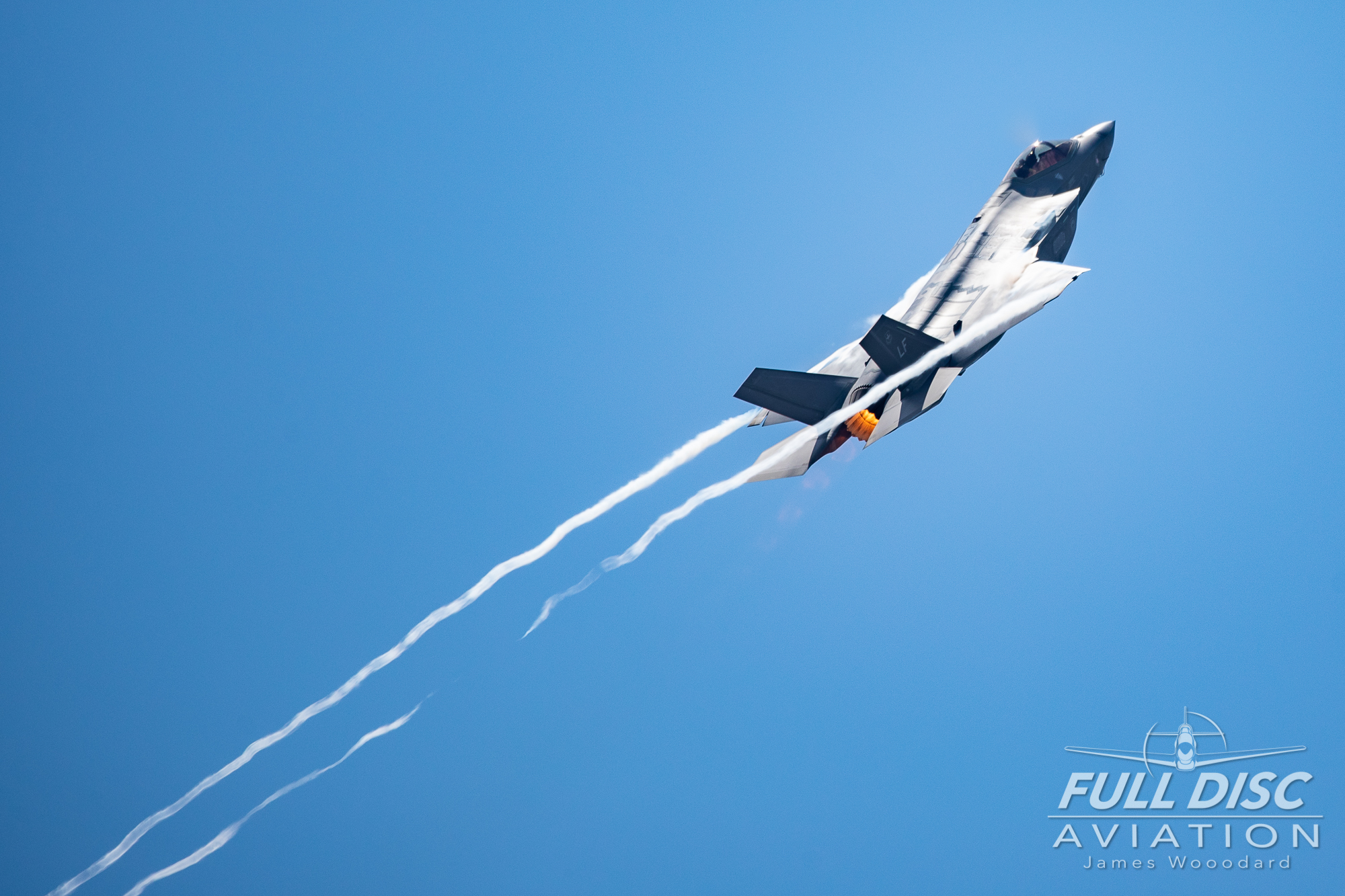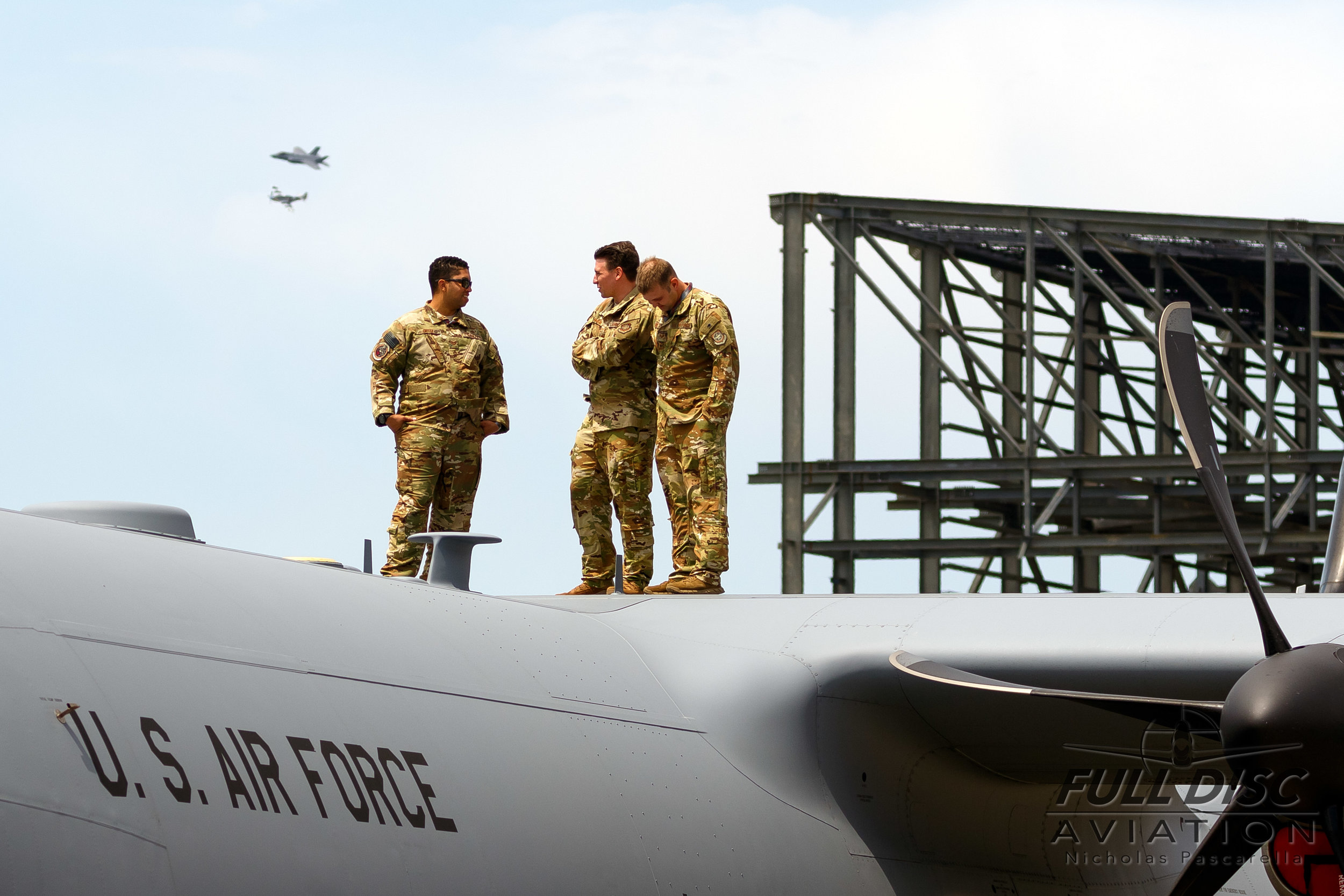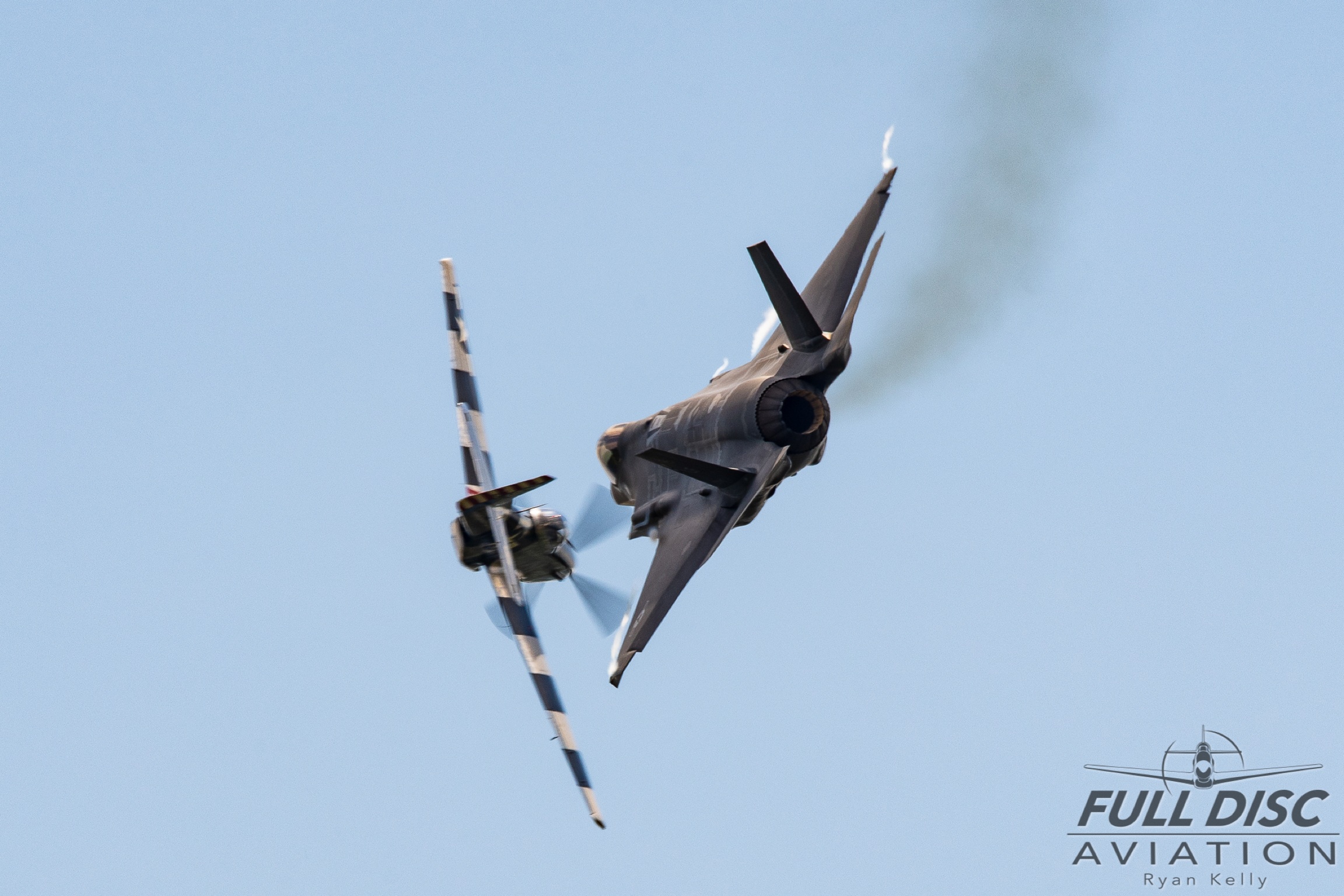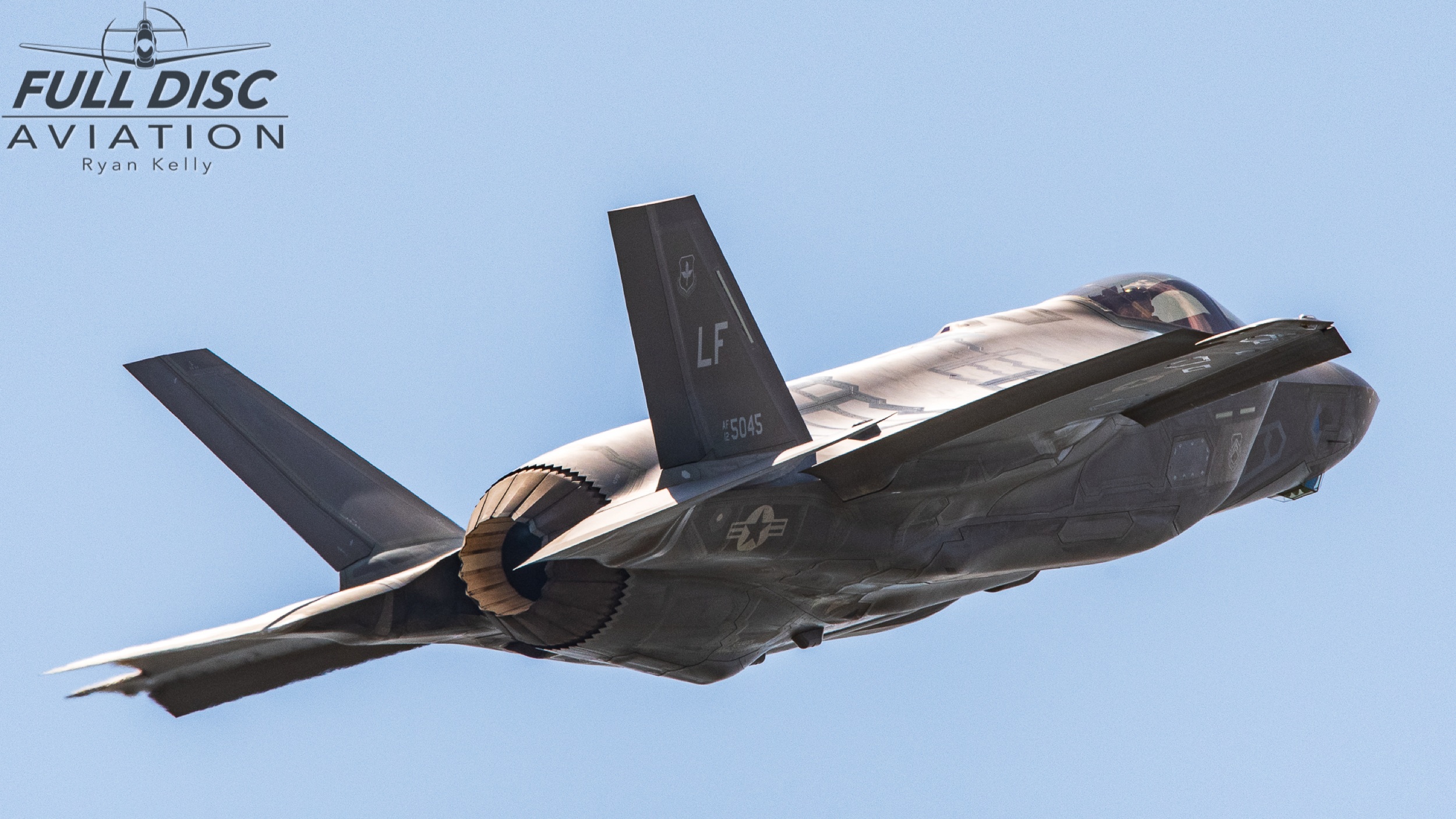USAF F-35 Lightning II Demonstration Team
Interview & Photography: Ryan Kelly, Nicholas Pascarella, James Woodard, Ryan Tykosh
[Editor's note:] The F-35 Lightning II is our newest stealth fighter aircraft. For years, as sensor packages were upgraded and other systems brought online, the jet was not displayed for the public except in static displays or Heritage Flight sorties at airshows. We got a taste, but not enough to quench the thirst for the public's curiosity. But finally, after years of waiting, the F-35 Lightning II Demonstration Team gets to stand up the jet in front of millions and display the incredible raw power and agility of this aircraft.
Full Disc Aviation traveled to Seymour Johnson Air Force Base in Goldsboro, North Carolina, to see the routine firsthand. That's never enough for us, however, and Ryan Kelly worked with PAO SrA Alex Cook in hopes of linking up before the show. Alex found us and introduced himself, introduced us to Captain Andrew "Dojo" Olson and SSgt Paul Ogletree, and escorted us out to the jet for a quick interview before the show.
The jet looked too simple sitting on the ramp. Every surface is smooth; no weapons stations on the wings, and it was missing the typical long antennae and protruding sensors except the most vital...but rest assured, this jet contains the systems to quarterback an entire fighting force, carrying its own lethal ordinance, all with the radar cross-section of a pigeon. Not to mention employing one of the most powerful engines ever built.
The crew was laid back, enjoying a cool, cloudy, North Carolina morning on the Seymour Johnson ramp alongside the most advanced fighter jet on the planet. We chatted with Dojo, SSgt Ogletree and SrA Cook for a half hour and got some shots of the jet on the ramp, looking like a life-sized toy up close. Being the first year for the full demo and only a couple shows into the season, the excitement and joy from the crew was palpable.
Dojo shredded the routine, tearing around the sky and deafening anything without hearing protection. Don't let their relaxed demeanor fool you; he and the rest of the team are at the absolute top of their game, and they relish the mission of showcasing the F-35's special brand of airpower across the country this year. It is with great joy I present to you the 2019 F-35 Lightning II Demonstration Team. [-np]
*edited for content and clarity
FDA: What inspired you to fly?
Captain Andrew "Dojo" Olson: I guess I was inspired to fly by [the movie] Top Gun…[I saw it first] when I was two...I mean really, that's it. I saw that when I was two and I've wanted to do that ever since; I'm just lucky to do it. It's a combination of timing and luck to get to this point, but that's what started it. I think what keeps me going is looking back on the history of the Air Force and trying to make the guys before us proud...especially [legendary jet pilots] like Robin Olds…[I look up to him and contemplate]; are we doing it good enough for them? I think they'd be proud of what we're doing…[we're incorporating the lessons learned from earlier years] and we're flying hard...
Olds was a legend...what was the first plane you flew?
Dojo: When I was in high school, every penny I made was by filling up airplanes with gas at my local airport, and I blew all my money to get my PPL and I did it in the Diamond DA20. In college, I realized that [the Air Force] was an option for me because [I didn't have perfect vision, I didn't realize you could get lasik surgery and still fly fighters…]. So, for a long time, I thought commercial was all I could do, even though growing up, all I wanted to do is fly fighters. I thought commercial was really my only option and that's a whole different story. But anyway, I took lessons in the DA20, then in college when I realized I could do the Air Force thing, I went through the initial flight screening, just to really quickly washout 15 to 20%, [but I made it through that]...
Has anything stood out to you this year?
Dojo: Yeah, a lot of things already... in Melbourne, Florida, we had Lockheed Martin employees come up from their Orlando branch [to watch the jet fly] and the feedback we got that day from them watching their airplane fly...they said it was the highlight of their careers and really one of the coolest things even in their personal lives. They work on the mission systems in the airplane, so they're not necessarily around the airframe itself and a lot of them had never even seen the jet in person... I would liken it to a NASA engineer watching the space shuttle launch for the first time in their life...that was awesome. Just being able to showcase that to them, [the people that worked so hard] and meet the engineers who [can say, yep, that's my part]. That was cool...that one definitely sticks out ...and then just the the F-35 fans out there. There's a nation of F-35 fans that I realized were there all along but they've definitely come out of the woodwork now...they just enjoy watching the jet do what it can do. The reactions on social media have been really positive and you can really feel the social opinion on the jet change with every demo... the needle is moving with every demo. Watching the comments and stuff on YouTube, they're largely, shockingly, all positive...there's a lot of people that just troll out there. [laughter] It's just been really good so far and we're just getting started.
Image Credit - ALEXANDER H. COOK, SrA, USAF
That's cool...is it a good feeling to know you're proving the naysayers wrong about this jet?
Dojo: Yeah. It's really good. And you know, I've only been in the program for short time...about three years, which is really nothing compared to some of the leadership back on base who have been in it for eight or ten years... and I think even for them, they're taking a lot of [joy from the feedback] but the pride factor of the airplane lies generally in the non-airshow stuff...what we show at airshows is super cool and impressive, but it's the tip of the iceberg of what makes the plane cool. [So, like the Raptor], people buy into the airshow stuff, as they should, because it's pretty cool and it's nimble and it does cool things but ...if they only knew the rest of the stuff, they'd be doing back handsprings about it.
What would you say to guys that are looking to start flying?
Dojo: In aviation in general, there has never been a better time to get into aviation, commercial or military. The demand for pilots and even all the support crew as well, maintenance, everything...there's never been a better time...I think the Air Force is a door that you can only walk through at [a younger] age. The airlines are always going to be there but the Air Force door is a super exciting one...getting to fly jets like this all over the world, do all the service stuff and really just make a difference...we're part of what is essentially one of the hottest tech companies in the world that also happens to drop bombs [laughter]...so, the path for them would be: good grades in high school, college ROTC, maybe the Air Force Academy, get a commission in the Air Force, and then compete for a pilot slot, go to pilot training...just do as well as you can in pilot training, and that will keep as many doors open as possible for what you get to fly.
What's next for you?
Dojo: We do a two year rotation for this. This is really considered my second year because we were Heritage Flight only last year, but that was still a busy year for me on the airshow circuit. I plan to upgrade a new pilot in the offseason, pass the team off and then I will go back to what I do now part-time, which is instruct students at Luke Air Force Base. So, I'll go back to doing that full-time, which I really enjoy doing. I love teaching the new guys...we have 23 year olds right out of pilot training flying [the F-35]. We have guys that have flown nothing but T-6s or T-38s and go strap this thing on and go fly by themselves for the first time. It's pretty cool taking them from that very first sortie to the end of their basic course syllabus, and they are so capable. It's unreal compared to where I was at the end of my Strike Eagle basic course, they are out there commanding lanes at Red Flag...so, that's what will be next. I'll continue teaching in the airplane.
How was the transition from the F-15 to this? Was it difficult?
Dojo: No, not at all. And I think part of it is the core of Air Force training in T-38s is to teach you to be a single seat fighter pilot, and I just fell back on what I recalled from those days and that helped. Once you sit in it, this airplane is so intuitive to fly and operate; all the screens are customizable and so is their layout, so whatever works for your brain [is what you can set up…] I would say, generally speaking, no two pilots fly with the same screen layout; it's kind of like dragging apps around. It's super intuitive to fly this airplane and interpret the data that it's showing you... it does all the hard work for you with sensor fusion...whereas in the Strike Eagle, I was running the radar separately than the targeting pod...so I found the transition to actually be pretty straightforward, and with only a couple hundred hours in this airplane, I felt just as confident and comfortable as I did after a thousand Strike Eagle hours...this jet just gets better with every software revision that's coming out. It's just getting more and more intuitive and the pilot vehicle interface buttons are getting more and more intuitive and better and more efficient. I have to spend almost zero time touching the glass because everything is just on the stick and throttle.
Who's this guy here?
Dojo: [laughter] Paul is one of our crew chiefs. The pilot obviously is the one that people always focus on, but the guys that wear these uniforms represent the absolute pinnacle of their career fields...these are the best maintainers in the Air Force, period. And the guys back home are jealous because if anything ever needs to be fixed on the road with these jets, we can do it with just a few guys because they're the absolute best at what they do. Alex is also the best at what he does in public affairs...
How'd you get into this, Paul?
SSgt Paul Ogletree: I came straight out of high school, I had a basic idea of what I wanted to do...I was going to actually join Special Forces and the Air Force came out and asked me, hey, if you don't join special forces, would you be inclined to take this mechanic's job? I said yes, so I was going into open mechanical with no idea what I was going to do. I got through basic training and that's when they allow you to pick your aircraft or what you want to work on. So, I picked C-130s. My father was a C-130 Crew Chief also, so I figured, what better way to follow his footsteps? I did about five years on the C-130 learning the ropes on that as an Airman, and then they said hey, we're building up the F-35 program, we need maintainers now...so, I took the job for the F-35. They sent me out to Luke Air Force Base and they had some Heritage Flights and the demo teams come through, and I was like man, I have to capitalize on that. So, I worked as hard as I possibly could and now I'm here working on the F-35, one of the most epic aviation jobs I think that's in the Air Force today.
Did you know there was a demo team for the F-35?
SSgt Ogletree: Realistically, coming into Luke Air Force Base, I had absolutely no idea that they even had a Heritage Flight team for the F-35... I didn't even know what the F- 35 was when I got here. I took the assignment and asked my Master Sergeant what an F-35 was and he said, I'll show you! They took me in the hangar and I was thinking man, there's so many things that stood out. I'm coming off a C-130 and I'm coming into the F-35...it's a totally different airframe. I just took the opportunity and ran with it. I saw there was a demo team and I thought, I'm going to work as hard as I possibly can. I want to be a part of that.
Was it challenging going from the C-130 airframe to the 35?
SSgt Ogletree: A lot of people just think, if you can work on an airplane you can work on them all...I did get my A&P license (airframe and powerplant) ...that's pretty big for a mechanic to get, especially working on civilian aircraft...but coming from the Hercules C-130, it's a heavy world... working with cargo [it's a slower process than] opposed to [fighters], working with four engines instead of one, then you're coming into a high paced environment on the F-35. Everything's high-paced...it's faster, turns are quicker, and the jet lands and next thing you know, you're inspecting it, and not even 30 minutes later, the pilot's walking out waiting for you to salute him, hop in and start the motor. On heavies, you got your loadmaster coming in, he's loading all his gear up, you're making sure he's good with everything, making sure the rails are good, the transport is good, the next thing you know, you got your flight engineer coming up to do a check on the aircraft for the inspection. He's on comms, you're on flight controls, he's checking the motors and everything and then you're done with him...but you still have two more pilots to go through an inspection with, so you're going with them. You're looking at a bigger window, a four hour window, for a heavy flight; something that could take 15 minutes on a fighter. You're moving quick...and it's crazy, because on the Hercules, you have a hydraulic shop. You have an engine shop. You have Crew Chiefs, which I am, and then you have electrical, environmental, you have comm, nav, and you have a variety of other back shops. And on this, you have a Crew Chief and you have your avionics... so, for the Crew Chief you're combining three shops all together, and avionics... those guys are working just as hard. With it being such a new program and everything getting ramped up so quickly, everyone's got to work that much harder.
What is next for you after this?
SSgt Ogletree: Once I'm done with the demo team... it's only a two-year gig, same thing as it is for the pilots. After this, I actually want to follow what Dojo's doing. He trains all the new F-35 pilots… I actually want to use my experience being a fully qualified Staff Sergeant on this aircraft, and I want to train new guys to be F-35 mechanics. That's what I'm working on. Also, I've been talking to Dojo and he's going to try and hold my hand and bring me into the pilot life; we chat all the time. And sometimes it gets to me, I'm thinking yeah, I want to do exactly what he does...I wouldn't say Dojo is necessarily my idol, but I look up to him...I will say that I hope he drags me with him. [laughter] I really, really like what he does.
What's one of the highlights for you on the team so far?
SSgt Ogletree: Our very first show was actually Melbourne...I'm from Florida, and that was my hometown show. It was definitely an experience, bringing back my work with me to the actual city I grew up in. With the space shuttle and everything; that probably drove me to work with the F-35... but that would be my highlight because it was my first show. Just being around family, I was able to say hey, Mom and Dad, come check out the F-35, hey friends and family that I knew from back home, come check out the F-35. I remember we just landed, I just brought Dojo in, stopped, we threw chocks on it...and we got the jet inspected, next thing I know I had Florida Today, one of the biggest news companies out there saying we want to do an interview on you. I was front page news. I still have that...I'm going to frame it.
Sick!
SSgt Ogletree: Yeah..this is the pinnacle of what I've been working towards in my life for the past eight years. I'm on the front page news on my hometown and I would say that right there would be my highlight of my time on the F-35 demo team.
Do you ever get frustrated that you put in all this time on this aircraft and Dojo takes it up and breaks it and brings it back to you, says 'alright' and walks off?
SSgt Ogletree: [laughter] A lot of Crew Chiefs say that the pilots go up and bring it back broken, but realistically, that's not the case with this jet. Lockheed Martin gave us a really good jet and I tell everybody that all the time. If you look at it...I can walk directly under this wing and not get hit in the head... and if there was maintenance [to do on the jet] it's not hard to perform...You get on the computer you look at the codes and everything is standard...When I got on the 35 program, I had no idea how to do anything...I had come from the C-130…but, when Dojo comes down and says, hey, this happened, all I have to do is dig into my computer. It's not paper anymore. Lockheed laid it all out step by step. I want to tell especially the younger generation about these things, working on the F-35, you obviously have to know things as far as safety concerns, but going through this step-by-step job, you're good to go...it's not difficult.
Do you guys get in a room and critique the demo together?
SSgt Ogletree: Yeah...we as the maintenance here, we actually video it. We video the whole demonstration, so that way Dojo can review tapes and everything...we can critique but I only have four stripes…[laughter] I'm a little low on the totem pole to be critiquing but Dojo takes consideration of the film. Filming the demo really helps [tighten up] the performance for the next show, and believe it or not, practice makes perfect and consistency is everything, so, I believe the filming definitely helps.
How about you Alex?
SrA Alex Cook: I'm Senior Airman Alexander Cook, F-35 Demo Team Public Affairs coordinator…[this is my second year] I've been on the team and it's awesome. I'm just super excited [with it being the] first year that we're full demo; just being able to document history behind my lens is an incredible feeling. I joined the Air Force late... I'm 29. I've been here for about three years now. I decided to wait a little bit to be sure what I wanted to do, but I used to do sports photography growing up... shot a lot of landscape photography, did a lot of traveling with my wife and I didn't know there was actual career field [for this] in the military until I went in talked to a recruiter...I put that down as my number one job I wanted to do and two weeks later I get a call from the career adviser saying that's available and you're shipping out. So, two weeks later I was out to basic training and after that I went to Fort Mead, a defense information school near Baltimore... DC area where they teach you photojournalism…[the course is] about seven months long. After I graduated there I got my first assignment at Luke Air Force Base where I ended up being on this team my second year. It's just awesome... I sometimes I can't believe I'm actually doing this. I'm traveling around...I've only been in three years and to have just that little experience and be able to do what I do is pretty cool and I'm pretty lucky to do that.
Have you had any super memorable moments on the team?
SrA Cook: Probably for me it was Chicago Air and Water show because of the opportunities we had for vantage points... I shot the airshow from across the street in this forty two story building and the jet was below me right over the water... of course being in the midwest, there's a lot of humidity...that day was probably the best photographic opportunity for me and I caught Dojo going over the water overlooking the entire air show...being up that high and looking down on the jet, vapor is just pouring off the wings and just filling the whole thing up and the shot made national news and ..I couldn't believe it …[I also feel like] it's really cool when the Air Force shares our content...I don't want to say it's expected but it's nice that they do. When you can reach civilian networks and other publications that are outside of the military, that's when you know you've done something great. And really, that's probably the most rewarding aspect in terms of photography for me. And of course, flying overseas in the KC-10, getting some shots of Dojo when they're refueling him...I didn't sleep once; we were just up and getting video and photos of that. That was fun. But that's probably the two most memorable moments for me.
How would you describe your style? Do you have a particular way you like to portray things with your artistic background?
SrA Cook: I do...my style is more environmental; I always want to put a place with a jet. I want that person to look at my image and think, I know where that was taken. [I'd rather them not think] oh, there's a jet and a blue sky, we don't know where [it was taken]… But I get the "insurance" shots when I get to a show on Friday or Saturday... I call then "insurance" because those are required...everyone wants to see tight shots of the jet, but I also try to get an environmental shot or something that gives a sense of place. So, I guess my style would be more just overall environmental shots of the aircraft at an airshow.
Image Credit - ALEXANDER H. COOK, SrA, USAF
You're bringing your landscape background into it.
SrA Cook: Yeah, exactly...landscape stuff, and just trying to get a little bit of everything because I'm a photojournalist. I usually try to tell a story, and sometimes that's really hard to do at an airshow, especially when we're doing 19 shows on the road. It can be a challenge, but I think just switching every vantage point and looking at your environment and your surroundings and trying to incorporate that into your shot, it's important.
You going to get Dojo to fly through [Star Wars Canyon] for you?
SrA Cook: Yeah, actually I am...We're going to try to get some of those shoots this year...While we're on the road we like to look for major landmarks…
Let us know! [laughter]
SrA Cook: Yeah! But also, my favorite part about this job is working with you guys, working with other photographers on the road and just sharing ideas and best practices. That's the best part about this; the community. And within aviation, it's awesome. We don't get back home a lot...on the road, we definitely [brainstorm] amongst ourselves in the military, but working with civilian photographers and people that are out there doing things a little bit differently, it's good to get that insight, and I love it.
Image Credit - ALEXANDER H. COOK, SrA, USAF
What's been the most challenging thing for you so far? For you personally.
SrA Cook: Most challenging thing for me is probably being everywhere at once. I'm the only one on the team that travels out on the road with these guys and does this job, so being able to strategically plan on what shots I'm going to get in just 15 minutes and really, our performance is less than 15, so having to plan and really execute, that's always a challenge for me. I obviously can do it, but doing media ops, doing community relations and setting up all the different things [we try to do] and trying to make sure those run smoothly while at the same time getting content and getting everything we need is a challenge.
You guys enjoy doing community outreach as well?
SrA Cook: The real reason why we do these airshows is...it's all about inspiring [the next generation]...we want to educate and reach out and get people to join the Air Force. This is a huge recruiting asset ...we always want to inspire people to do what we're doing.
What is next for you?
SrA Cook: I want to go to Syracuse University. There's a military journalism program there I want to get into; it's a 10-month assignment. I would PCS there and learn just a little bit more in-depth storytelling and learn how to do my job better and all the ins and outs...It's a pretty awesome program and there's only 30 people DOD-wide in the entire military that get accepted per year...It's pretty hard to get into but hopefully I have a good shot at doing it. But that's my next step.
Cool man!
SrA: This is my second year and just like Dojo, I'll hand this off to somebody else and let them do it.
Will you train them?
SrA Cook: Yeah, there will be some carryover I imagine...a few weeks of going to a couple shows and showing them how we operate...it should be pretty easy.
How are you enjoying the camaraderie or friendly challenge between you and the other demo teams?
SrA Cook: We love working with people in other demo teams, I guess that's one of the fun things; to not only work with our photographers but working with other demo teams and just helping each other out... a lot of times we'll shoot together, we'll shoot products for each other just to have fun with it...it's a very tight-knit community. We love the teamwork aspect of it and being on the road. Each time we get to do it, it's awesome.
[Editor's note:] We're humbled to include some of Alex's phenomenal photography within this interview. Full Disc Aviation would like to sincerely thank the F-35 Demonstration Team for their hard work, dedication and service. Special thanks to Dojo, SSgt Ogletree and SrA Cook for setting aside some of their valuable time to chat with us, and especially SrA Cook for helping set this up. [-np]
